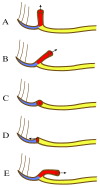Anatomy of Mandibular Vital Structures. Part II: Mandibular Incisive Canal, Mental Foramen and Associated Neurovascular Bundles in Relation with Dental Implantology
- PMID: 24421959
- PMCID: PMC3886037
- DOI: 10.5037/jomr.2010.1103
Anatomy of Mandibular Vital Structures. Part II: Mandibular Incisive Canal, Mental Foramen and Associated Neurovascular Bundles in Relation with Dental Implantology
Abstract
Objectives: The purpose of the present study was to review the literature of how to identify the mental foramen, mandibular incisive canal and associated neurovascular bundles during implant surgery and how to detect and avoid the damage of these vital structures during implant therapy.
Material and methods: Literature was selected through a search of PubMed, Embase and Cochrane electronic databases. The keywords used for search were mandibular incisive canal, mental foramen, mental nerve, anterior mental loop. The search was restricted to English language articles, published from 1979 to November 2009. Additionally, a manual search in the major anatomy, dental implant, and periodontal journals and books was performed.
Results: In total, 47 literature sources were obtained and reviewed. The morphology and variations of the mandibular incisive canal, mental foramen and associated neurovascular bundles were presented as two entities. It suggested that clinicians should carefully assess these vital structures to avoid nerve/artery damage.
Conclusions: The mandibular incisive canal, mental foramen and associated neurovascular bundles exist in different locations and possess many variations. Individual, gender, age, race, assessing technique used and degree of edentulous alveolar bone atrophy largely influence these variations. It suggests that the clinicians should carefully identify these anatomical landmarks, by analyzing all influencing factors, prior to their implant surgical operation.
Keywords: chin; cross-sectional anatomy; dental implants.; inferior alveolar nerve; mandible; radiography.
Figures








References
-
- Apinhasmit W, Chompoopong S, Methathrathip D, Sansuk R, Phetphunphiphat W. Supraorbital Notch/Foramen, Infraorbital Foramen and Mental Foramen in Thais: anthropometric measurements and surgical relevance. J Med Assoc Thai. 2006 May;89(5):675-82. - PubMed
-
- Jalbout Z, Tabourian G. Glossary of Implant Dentistry. Upper Montclair, NJ: International Congress of Oral Implantologists; 2004:16.
LinkOut - more resources
Full Text Sources
